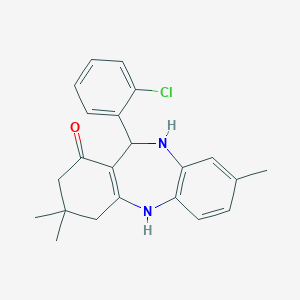

You can:
| Name | 11-(2-chlorophenyl)-3,3,8-trimethyl-2,3,4,5,10,11-hexahydro-1H-dibenzo[b,e][1,4]diazepin-1-one |
|---|---|
| Molecular formula | C22H23ClN2O |
| IUPAC name | 6-(2-chlorophenyl)-3,9,9-trimethyl-6,8,10,11-tetrahydro-5H-benzo[b][1,4]benzodiazepin-7-one |
| Molecular weight | 366.889 |
| Hydrogen bond acceptor | 3 |
| Hydrogen bond donor | 2 |
| XlogP | 5.2 |
| Synonyms | AC1MEDQA Oprea1_754033 AKOS016320891 MCULE-8169345289 AK-968/14004845 [ Show all ] |
| Inchi Key | IJMYVYYYYRIKRS-UHFFFAOYSA-N |
| Inchi ID | InChI=1S/C22H23ClN2O/c1-13-8-9-16-17(10-13)25-21(14-6-4-5-7-15(14)23)20-18(24-16)11-22(2,3)12-19(20)26/h4-10,21,24-25H,11-12H2,1-3H3 |
| PubChem CID | 2876782 |
| ChEMBL | CHEMBL564151 |
| IUPHAR | N/A |
| BindingDB | N/A |
| DrugBank | N/A |
Structure |  |
| Lipinski's druglikeness | This ligand has a partition coefficient log P greater than 5. |
You can:
| GLASS ID | Name | UniProt | Gene | Species | Length |
|---|---|---|---|---|---|
| 134766 | Neuromedin-B receptor | P28336 | NMBR | Homo sapiens (Human) | 390 |
zhanglab![]() zhanggroup.org | +65-6601-1241 | Computing 1, 13 Computing Drive, Singapore 117417
zhanggroup.org | +65-6601-1241 | Computing 1, 13 Computing Drive, Singapore 117417